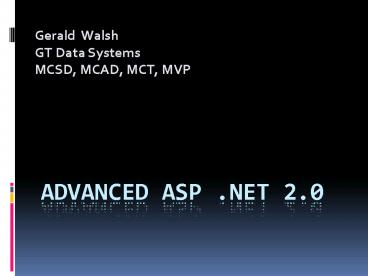Advanced ASP 'Net 2'0 - PowerPoint PPT Presentation
1 / 25
Title:
Advanced ASP 'Net 2'0
Description:
Writing custom HTTP handlers. Creating Asynchronous ASP.Net Pages. ASP.Net ... ASP.NET 2.0 APPLICATIONS Advanced Topics by Dino Esposito, Microsoft Press. ... – PowerPoint PPT presentation
Number of Views:231
Avg rating:3.0/5.0
Title: Advanced ASP 'Net 2'0
1
Advanced ASP .Net 2.0
- Gerald Walsh
- GT Data Systems
- MCSD, MCAD, MCT, MVP
2
Agenda
- Writing custom HTTP handlers
- Creating Asynchronous ASP.Net Pages
3
ASP.Net Request Processing
ASPNET_WP.EXE
Request is passed to the ASP.Net ISAPI
Interface ASPNET_ISAPI.dll via Named Pipe
HTTP Pipeline
HTTP Request
Web.config
HTTP Response
IIS 6.0 Server ISAPI Processes Request INETINFO.EX
E or DLLHOST.EXE
HTML Response Is returned back through the
ASP.Net pipeline.
ASP.Net HTTP Handler Code
4
the HTTP pipeline
- Foundation for ASP.NET pages Web Services
- General-purpose framework for server-side HTTP
programming
Pipeline Classes
Context Classes
5
Writing Custom HTTP Handlers
- ASP.Net is based on processing custom handlers.
- It provides several well known built-in handlers
- Page
- Web Service
- .Net Remoting
- Building Custom Handlers allow you to develop
your own processes in addition to these. - Custom handlers can offer much greater
performance than using pages and can process
requests in custom non-standard ways. - Implemented as a separate assembly or as an ASHX
file.
6
The IHttpHandler Interface
- Imports System
- Imports System.Web
- Public Class Handler Implements IHttpHandler
- Public Sub ProcessRequest(ByVal context As
HttpContext) Implements _ IHttpHandler.ProcessRequ
est - Code here to process request using
context object - End Sub
- Public ReadOnly Property IsReusable() As
Boolean Implements _ IHttpHandler.IsReusable - Get
- Return True
- End Get
- End Property
- End Class
7
Registering Your Handler
- Edit Web.config
- ltconfigurationgt
- ltsystem.webgt
- lthttpHandlersgt
- ltadd verb path.hdlr
- typeMyNamespace.MyHandlerClass, assembly
- validatefalse/gt
- lt/httpHandlersgt
- lt/system.webgt
- lt/configurationgt
8
Registering Your Handler in IIS6
- Register your custom file extension in the IIS
Metabase. - Web Application Properties ?
- Configuration ?
- Mappings
- Executable Path set to aspnet_isapi.dll
9
Registering Handlers in IIS7
10
Registering Handlers in IIS7
11
Alternate Method
- Add a ASHX resource to your project
- Includes a special directive
- lt_at_ WebHandler LanguageVB ClassNamespace.MyHa
ndler gt - The handler will run automatically when invoked,
no registration or deployment is necessary. - The registration is actually handled by another
built-in handler. - Quick Tip Add a CodeBehind attribute to the
WebHandler directive to use intellisense and
other code editor capabilities.
12
DEMO
- Building a simple HTTP Handler
13
Asynchronous Pages
- By default ASP.Net pages execute synchronously.
- When IIS is serving a large number of requests it
can run out of available threads. - IIS then returns a 503 Server Too Busy
response. - Async requests improve web server performance by
reducing thread contention in the ASP.Net process
request thread pool. - By default ASP.Net request queue holds a maximum
of 100 threads. - appRequestQueueLimit can be set up to 5000
14
The Page Async Attribute
- lt_at_ Page Asynctrue . . . gt
- Causes the page parser to generate the
IHttpAsyncHandler interface in the dynamically
generated class. - This then allows for asynchronous handlers to be
registered for the PreRenderComplete event.
15
IHttpAsyncHandler
- A standard Async processing design pattern that
Implements two methods - BeginProcessRequest(HttpContext, callback,
object) - EndProcessRequest(IAsyncResult)
16
AddOnPreRenderCompleteAsync
- Handles registration of asynchronous event
handlers to execute during the pages
PreRenderComplete event. - AddOnPreRenderCompleteAsync(
- new BeginEventHandler(BeginProc),
- new EndEventHandler(EndProc)
- )
17
Uses for Async Pages
- Long Running or Slow Database Operations.
- Calling Web Services.
- Fire and Forget Web Page Requests.
18
DEMO
- Building an Asynchronous ASPX Page
19
Resources
- Gerald_at_GTDataSystems.com
- Book Programming Microsoft ASP.NET 2.0
APPLICATIONS Advanced Topics by Dino Esposito,
Microsoft Press. - http//www.ASP.Net
- http//msdn.microsoft.com
- http//msdn.microsoft.com/msdnmag/issues/02/09/htt
ppipelines/
20
The ASP.net Cache Object
- A hashtable used to store frequently accessed
data. - Global to the application.
- Similar to the Application object but has
additional management functionality. - Dependency Functionality
- Sliding and Fixed Expiration of Data
- Prioritization of data in cache
21
Cache.Add
- Cache.Add(
- Key as string,
- Value as object,
- Dependencies as CacheDependency,
- AbsoluteExpiration as Date,
- SlidingExpiration as timespan,
- Priority as CacheItemPriority,
- onRemovedCallback as CacheItemRemovedCallback
- )
22
Cache Dependencies
- CacheDependency Object
- Can Be
- File
- Directory
- SQL Server Data Dependency
- Custom Dependency
- Can be bound to multiple cache items
- Cache.Insert(Key, Value, Dependency)
23
SQL Cache Dependency
- Supported on SQL 7.0 and later
- Managed with the SqlCacheDependencyAdmin object
- SQL Must first be configured to support
dependencies. - Use aspnet_regsql.exe d ltdbnamegt or
EnableNotifications method in code.
24
SQL Cache Dependency
- Creates a table in the DB to track data changes
in enabled tables. AspNet_SqlCacheTablesForChangeN
otification - Call to EnableTableForNotifications adds triggers
and table entry to track changes. - SqlCacheDependency object periodically queries
the table to check for data changes.
25
DEMO
- Using the Cache Object































